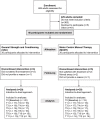General strength and conditioning versus motor control with manual therapy for improving depressive symptoms in chronic low back pain: A randomised feasibility trial
- PMID: 31369613
- PMCID: PMC6675067
- DOI: 10.1371/journal.pone.0220442
General strength and conditioning versus motor control with manual therapy for improving depressive symptoms in chronic low back pain: A randomised feasibility trial
Abstract
Objectives: Exercise can be used as a treatment for depressive symptoms in the general population. However, little is known as to whether exercise has mental health benefits for adults experiencing chronic low back pain (CLBP). The aim of this study was to examine the feasibility of two intervention protocols commonly used in clinical practice for treating chronic low back pain, but with differing exercise dose, on depressive symptoms.
Methods: Forty men and women (mean age = 35) experiencing chronic persistent (>3 months), non-specific low back pain were recruited into a randomised clinical trial during 2015-2016. Participants were randomised to receive motor control (low-dose exercise) and manual therapy (n = 20), or general strength and conditioning training (moderate-dose exercise) (n = 20). Depressive symptoms were assessed fortnightly throughout a 6-month follow-up period using the Centre for Epidemiologic Studies Depression Scale (CES-D 10). Linear mixed models were used to examine within-group and between-group changes in depressive symptoms.
Results: Mean CES-D 10 score at baseline was 9.17 (SD = 4.32). There was evidence of a small decrease in average depressive symptoms over time (β -0.19 per fortnight, 95% CI = -0.34, -0.02). However, there was no evidence that change over time was dependent on treatment group.
Conclusions: Reduction in depressive symptoms amongst adults with CLBP occurred with both treatment methods (motor control [low-dose exercise] and manual therapy; or general strength and conditioning [moderate-dose exercise]). Further interventions including a true control group are needed to draw conclusions as to the effectiveness of each of these treatment methods on depressive symptoms amongst adults with CLBP.
Trial registration: Australian New Zealand Clinical Trials Registry, ACTRN12615001270505. Registered on 20 November 2015.
Conflict of interest statement
The authors have declared that no competing interests exist.
Figures
References
-
- World Health Organization. Depression and Other Common Mental Disorders: Global Health Estimates. Geneva: World Health Organization, 2017.
Publication types
MeSH terms
Associated data
LinkOut - more resources
Full Text Sources
Medical



